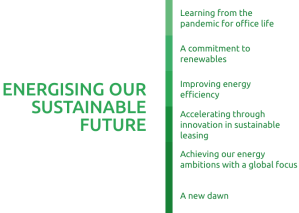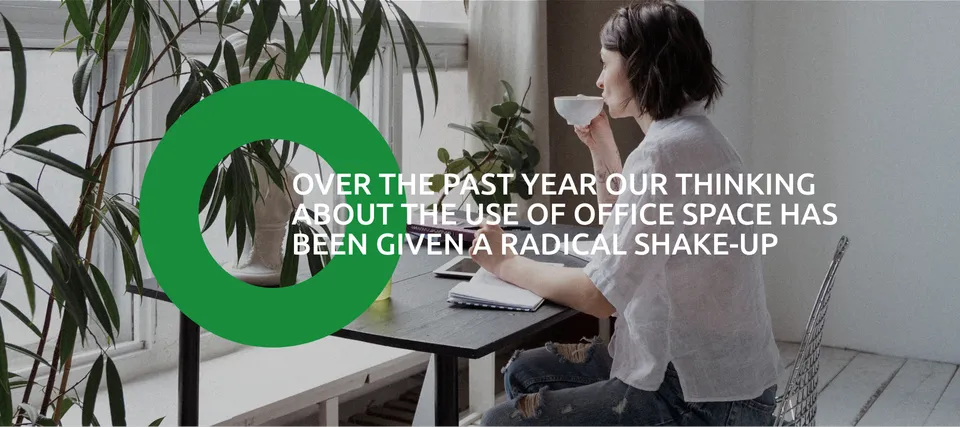Energizing our sustainable future on our road to net zero
Blog: Capgemini CTO Blog

It’s no surprise that as a global company with over 270,000 employees in 50 countries and more than 640 office buildings, energy from both our offices and our data centers has traditionally been one of our largest sources of carbon emissions and a key focus area on our road to net zero. It has been almost a year since we made our commitment to be a net zero business by 2030, and so I wanted to reflect on some of the progress we’ve made thus far.
The global COVID-19 pandemic has accelerated a change for us at Capgemini with the establishment of the new normal of hybrid working. This, coupled with innovation in our overall approach to office leasing, with a new and award-winning Green Lease framework, with a significant focus on energy-efficiency initiatives when we do return to our offices, and of course, with our commitment to 100% renewable electricity, like in India where the renewable energy market is evolving and growing, is allowing us to enable real progress in this area.
Over the past year, our thinking about the use of office space received a radical shake-up as the bulk of our workforce shifted to a work-from-home model. And while more of us are gradually returning to the physical workplace, the impact of COVID-19 will have a lasting impact on the future of work and, consequently, our energy use.
With the pandemic revealing what’s possible by way of hybrid (at home/in the office) work, many of us will continue working from home for some or most of the time and we have developed a new framework for this new normal, expecting employees to spend significant time working from home – which will have a lasting impact on our office energy consumption. We need to recognize that there are carbon emissions associated with working from home too, and we are focusing separately on this as part of our emissions reduction program.

A transition to 100% renewable electricity by 2025 was a key commitment when we announced our new targets last year. Since then, we have signed up to RE100 to reinforce this commitment to renewable electricity.
While this has been a focus area for us for a number of years – data reported in 2020 shows that we have doubled the proportion of electricity from renewable energy over a two-year period – we have seen significant progress on renewables in the last 12 months, with many countries realizing the switch. Currently, our countries on 100% renewable electricity include *Denmark, Belgium, Brazil, Finland, Ireland, Italy, Luxembourg, the Netherlands, Spain, Sweden, and Switzerland.
We are especially proud of the impressive strides made by our teams in India, where the renewable energy market is quite challenging.
Firstly, to address this head on, we have made a commitment to doubling our own onsite generating capacity for renewable energy across our campuses in India. Already, we have installed another 8,400 solar panels, bringing online an additional 3.1 MW of generation capacity.
Together with our real-estate partners and landlords, we are working on renewable energy contracts, making the switch last month at our Mumbai Vikhroli facility. We are also working with suppliers in other locations – Mumbai Airoli, Pune/ Hinjewadi, and Talwade – to replicate similar green energy procurement for our facilities.
This builds on solid foundations. Our Bangalore facility became the first corporate campus in India to receive the “Net-Zero Energy – Platinum” certification from the Indian Green Building Council (IGBC) for generating at least as much energy as it uses.
In fact, the energy we generated there and in other facilities, including Hyderabad, during the pandemic, has enabled us to export surplus renewable energy to the state electric grid.
If sourcing is one strand of our focus on energy, efficiency is the other. We know that with many employees working from home, we’ve reduced the need for energy at our offices, but we must still find ways to continually optimize what energy we do need.
The majority of our countries are well under way with country action plans to meet our targets, and many new energy efficiency projects are already up and running. These include implementation of new LED lighting upgrade and control in the UK, France, and Spain and new LED light fittings in India as well as smart meter implementations in Germany. And, in India, improvements in air conditioning systems are underway.
A key innovation for us this year is a new sustainable approach to how we lease buildings. We have developed a new Green Lease framework in partnership with our property agent, Cushman & Wakefield, who has helped us transform our green lease goals into a global implementation plan.
This will have a significant impact on our real-estate portfolio. We believe it’s one of the first of its kind – and we were recognized as Green Lease Leaders earlier this year by the Institute for Market Transformation (IMT) and the US Department of Energy’s (DOE) Better Buildings Alliance.
The framework means that sustainability selection criteria will be applied when choosing buildings and renewing leases. These cover topics including renewable energy, energy efficiency and monitoring, sustainability accreditation, electric vehicle charging points, and proximity to public transport. We expect 15% of a real estate portfolio to meet the Green Lease-defined criteria by the end of the year.
In establishing a unified approach to property leasing, the Green Lease framework reflects a broader and conscious shift to central governance of our broader sustainable energy transition. As such, a new global energy board, consisting of regional corporate real estate representatives and sustainability country leads, has been established and is now responsible for overseeing and delivering our global energy targets. This includes developing our global energy strategies and policies, as well as managing the global and country-specific net zero energy roadmaps.
Country-specific targets enable the right actions at the country level, but this new centralized approach, enables us to better monitor, share best practices, and control our global energy emissions.
This year has seen much progress but our commitment to sustainable business isn’t new. We have been reducing our own environmental footprint for over a decade and, in January 2020, we delivered our target of a 30% reduction in carbon emissions per employee a decade ahead of schedule (before the COVID-19 lockdowns began).
However, the scale and urgency of the global climate crisis demands new thinking and a significant ramping up of effort. How we respond demands not only strategic intent but innovative thinking and local adaptation as we progress on our road to net zero.
* excluding some sites from the Altran organization acquired in April 2020






